Paper Menu >>
Journal Menu >>
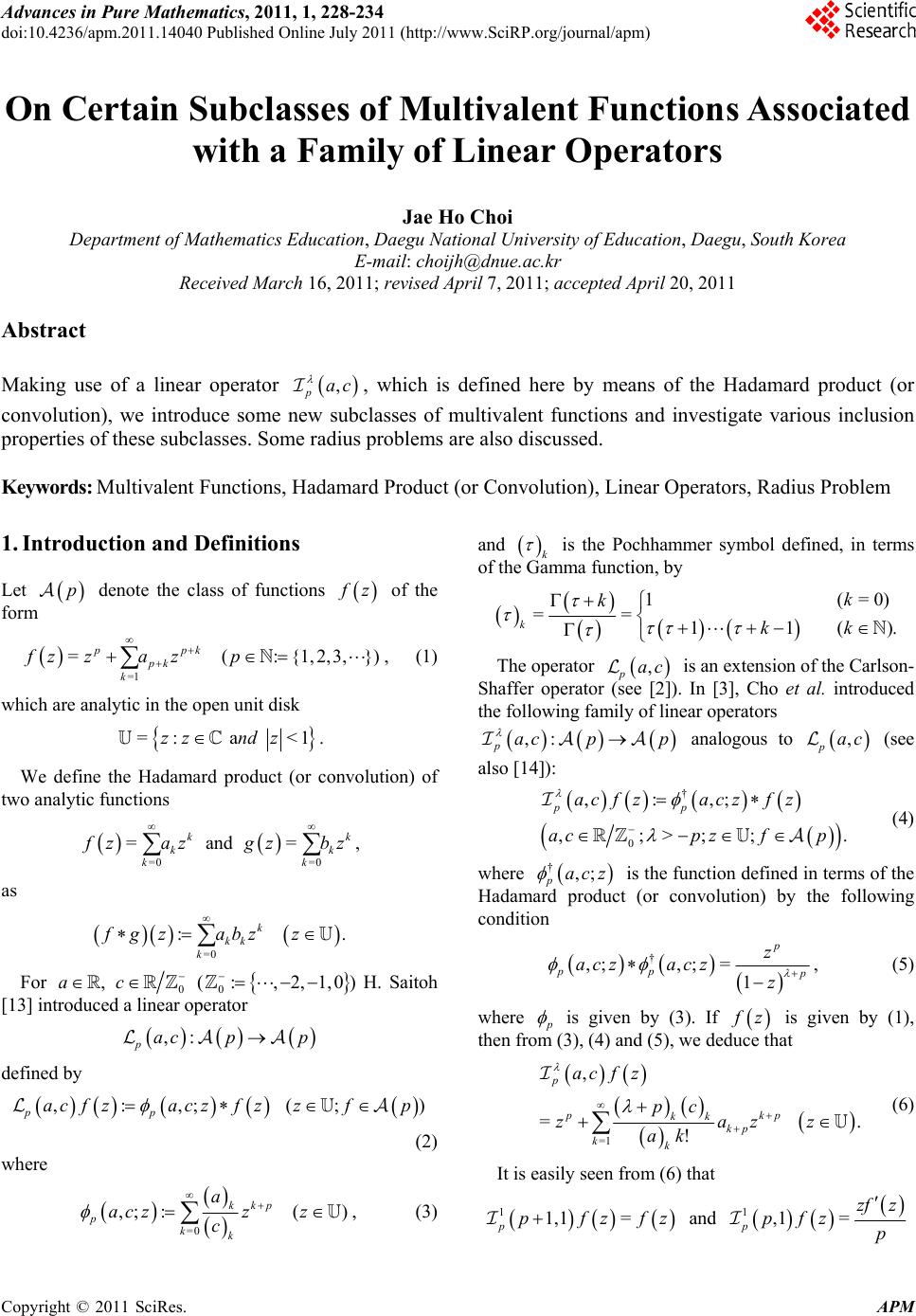 Advances in Pure Mathematics, 2011, 1, 228-234 doi:10.4236/apm.2011.14040 Published Online July 2011 (http://www.SciRP.org/journal/apm) Copyright © 2011 SciRes. APM On Certain Subclasses of Multivalent Functions Associated with a Family of Linear Operators Jae Ho Choi Department of Mathematics Education, Daegu National University of Education, Daegu, South Korea E-mail: choijh@dnue.ac.kr Received March 16, 2011; revised April 7, 2011; accepted April 20, 2011 Abstract Making use of a linear operator , which is defined here by means of the Hadamard product (or convolution), we introduce some new subclasses of multivalent functions and investigate various inclusion properties of these subclasses. Some radius problems are also discussed. , pac Keywords: Multivalent Functions, Hadamard Product (or Convolution), Linear Operators, Radius Problem 1. Introduction and Definitions Let denote the class of functions p f z of the form =1 =(:{1, 2,3,}) ppk pk k fzza zp , (1) which are analytic in the open unit disk =: a <1zz ndz . We define the Hadamard product (or convolution) of two analytic functions =0 =0 =and= kk kk kk f zaz gzb z , as =0 : k kk k fgzabz z . For , a0 c () H. Saitoh [13] introduced a linear operator 0:,2,1, 0 ,: pac pp defined by ,:,; (; pp acf zaczfzzfp ) (2) where =0 ,; :() kp k p kk a aczz z c , (3) and k is the Pochhammer symbol defined, in terms of the Gamma function, by 1( == 11( =0) ) k k k kk . The operator , pac is an extension of the Carlson- Shaffer operator (see [2]). In [3], Cho et al. introduced the following family of linear operators ,: pac pp analogous to , pac (see also [14]): † 0 ,:,; ,;>;; pp acf zaczf z acpz fp . (4) where †,; pacz is the function defined in terms of the Hadamard product (or convolution) by the following condition † ,;,; = 1 p pp p z acz acz z , (5) where p is given by (3). If f z is given by (1), then from (3), (4) and (5), we deduce that =1 , =. ! p pk kk kp kk ac fz pc zaz ak p z (6) It is easily seen from (6) that 11,1 = ppfzfz and 1,1= p zf z pfzp 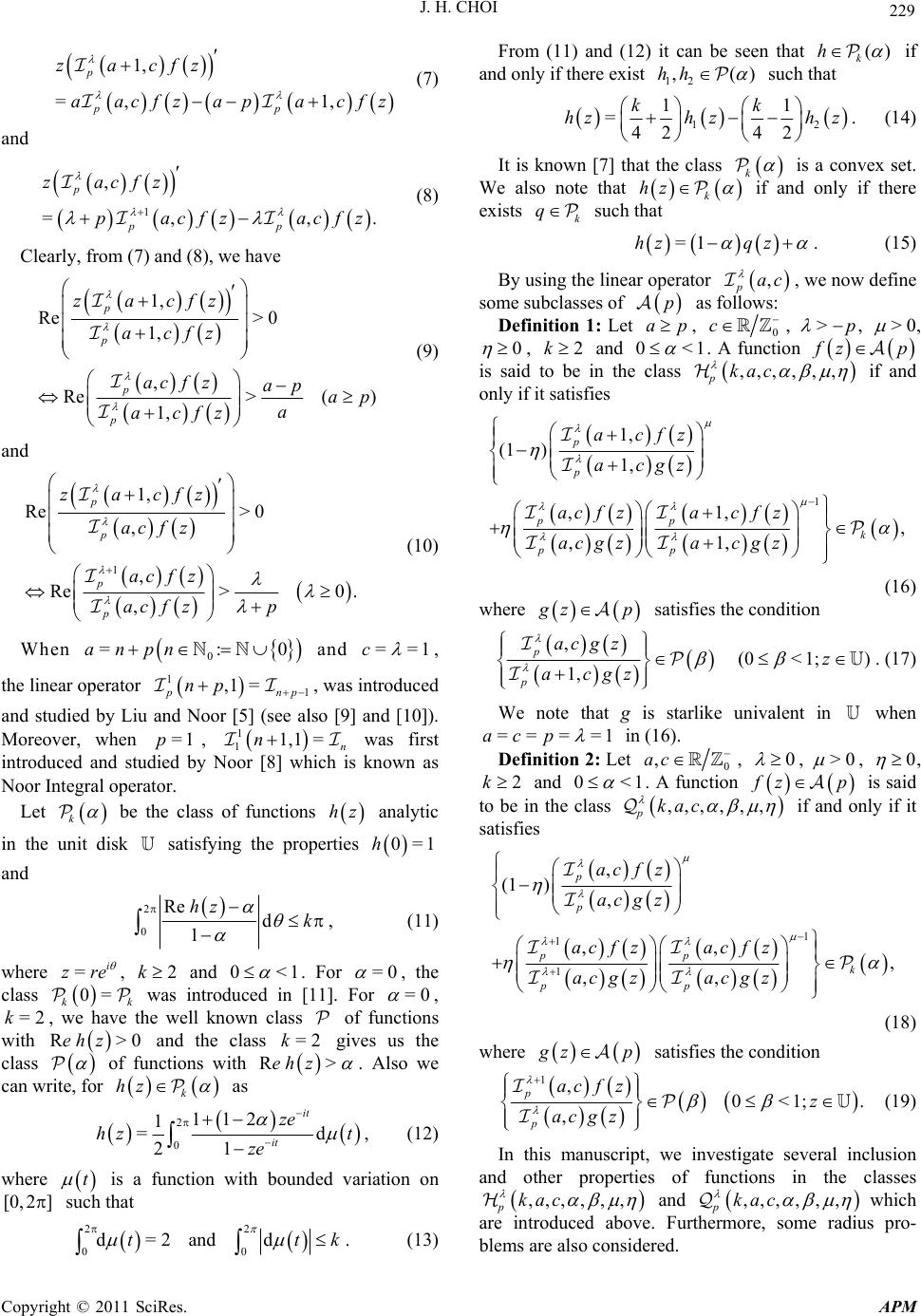 J. H. CHOI 229 . 1, =, 1, p pp zacfz aacfzapacfz (7) and 1 , =, , p pp zacfz pacfz acfz (8) Clearly, from (7) and (8), we have 1, Re> 0 1, , Re>( ) 1, p p p p zacfz acfz ac fzap ap a acfz (9) and 1 1, Re> 0 , , Re>0 . , p p p p zacfz ac fz ac fz p ac fz (10) When and 0 =:anpn 0==1c , the linear operator 1 1 ,1 = p np np , was introduced and studied by Liu and Noor [5] (see also [9] and [10]). Moreover, when , was first introduced and studied by Noor [8] which is known as Noor Integral operator. =1p 1 11,1 =n n Let k be the class of functions analytic in the unit disk satisfying the properties hz 0=1h and 2 0 Re d 1 hz k , (11) where =i zre , and 2k0<1 . For =0 , the class k was introduced in [11]. For 0= k =0 , , we have the well known class of functions with and the class gives us the class =2k =2 Reh z >0k of functions with zReh > . Also we can write, for k hz as 2 0 112 1 =d 21 it it ze hz t ze , (12) where is a function with bounded variation on such that t [0, 2] 22 00 d=2anddtt From (11) and (12) it can be seen that () k h if and only if there exist 12 ,(hh ) such that 12 11 =42 42 kk hzh zhz . (14) It is known [7] that the class k is a convex set. We also note that k hz if and only if there exists k q such that =1hz qz . (15) By using the linear operator , we now define some subclasses of , pac p ap as follows: Definition 1: Let , 0 c , >p , >0 , 0 , and 2k0<1 . A function f zp ,, , is said to be in the class ,,, pkac if and only if it satisfies 1 1, (1 )1, ,1, , ,1, p p pp k pp acfz acgz acfza cfz acgza cgz (16) where g zp satisfies the condition ,(0< 1;) 1, p p ac g zz acgz . (17) We note that g is starlike univalent in when === =1ac p in (16). Definition 2: Let 0 ,ac , 0 , >0 , 0 , and 2k0<1 . A function f zp is said to be in the class ,,,,,,kac p if and only if it satisfies 1 1 1 , (1 ), ,, , ,, p p pp k pp ac fz ac g z ac fzac fz ac gzac gz (18) where g zp satisfies the condition 1,0<1; , p p ac fzz ac gz. (19) k . (13) In this manuscript, we investigate several inclusion and other properties of functions in the classes ,,, , , , pkac and ,,, , , , pkac which are introduced above. Furthermore, some radius pro- blems are also considered. Copyright © 2011 SciRes. APM 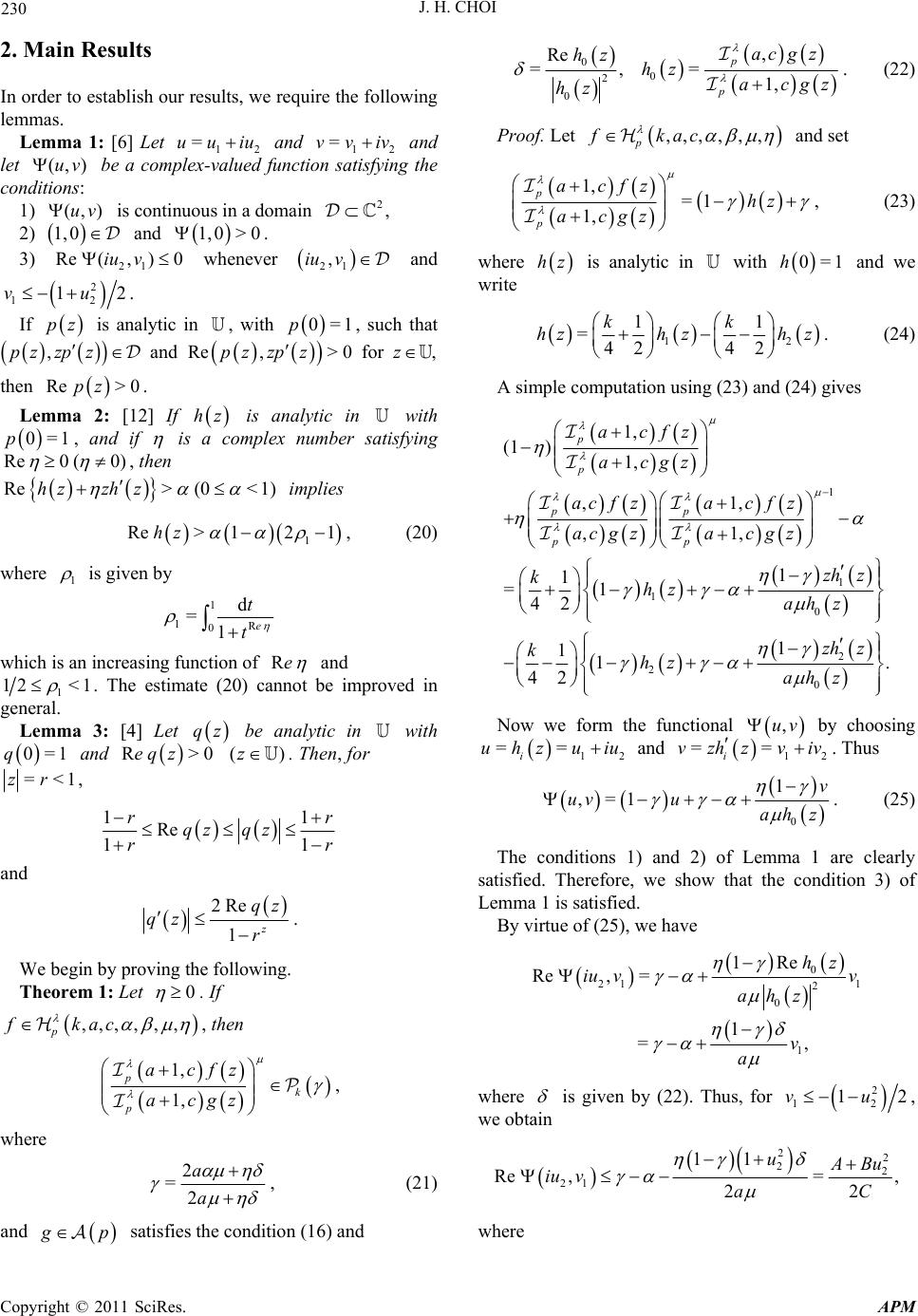 230 J. H. CHOI 2. Main Results In order to establish our results, we require the following lemmas. Lemma 1: [6] Let 12 =uu iu and 12 =vviv and let be a complex-valued function satisfying the conditions: (,)uv 1) is continuous in a domain (,)uv 1,0 2, 2) and . 1,0>0 0 3) whenever 21 )vRe (,iu 21 ,iu v and 2 12 12vu . If is analytic in , with , such that pz ,zp 0=1p pzz and > 0p z Re for ,pz z z , then . Re>0pz Lemma 2: [12] If is analytic in with , and if hz 0=1p is a complex number satisfying Re0 (0) , then Re>(0<1)hzzh z implies 1 Re>121hz , (20) where 1 is given by 1 1R 0 d =1e t t which is an increasing function of Re and 1 12 <1 . The estimate (20) cannot be improved in general. Lemma 3: [4] Let be analytic in with and . Then, for qz R>0 0=1q eq z(z) =<zr1, 11 Re 11 rr qzqz r r and 2Re 1z qz qz r . We begin by proving the following. Theorem 1: Let 0 ,, . If ,,,, p fkac , then 1, 1, p k p acfz acgz , where 2 =2 a a , (21) and g p satisfies the condition (16) and 0 0 2 0 , Re =,= 1, p p ac g z hz hz acgz hz . (22) Proof. Let ,,,,,, p fkac and set 1, =1 1, p p acfz hz acgz , (23) where hz is analytic in with 0=1h and we write 1 11 =42 42 kk hzh zhz 2 . (24) A simple computation using (23) and (24) gives 1 1 1 0 2 2 0 1, (1 )1, ,1, ,1, 1 1 =1 42 1 11. 42 p p pp pp acfz acgz acfza cfz acgza cgz zh z khz ah z zh z khz ah z Now we form the functional by choosing ,uv 1 == i uhzuiu 2 and . Thus 1 ==zv2i vzhiv 0 1 ,=1 v uv uah z . (25) The conditions 1) and 2) of Lemma 1 are clearly satisfied. Therefore, we show that the condition 3) of Lemma 1 is satisfied. By virtue of (25), we have 0 21 1 2 0 1 1Re Re, = 1 =, hz iu vv ahz v a where is given by (22). Thus, for 2 12 12vu, we obtain 22 22 21 11 Re ,=, 22 u A Bu iu vaC where Copyright © 2011 SciRes. APM 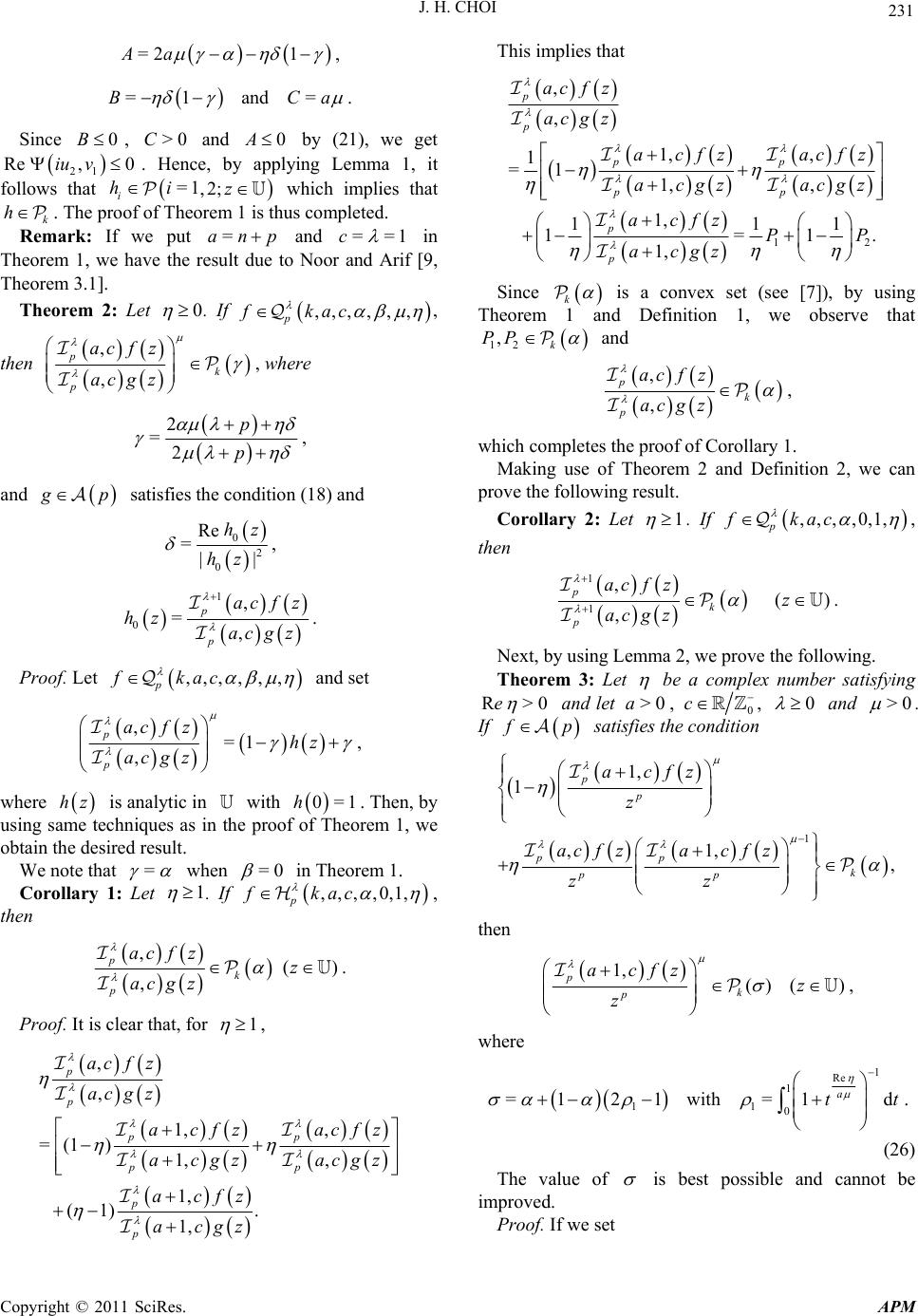 J. H. CHOI 231 =2 1Aa , =1 and=BCa . Since , and by (21), we get . Hence, by applying Lemma 1, it follows that which implies that . The proof of Theorem 1 is thus completed. 0B 21 ,v i >0C =1hi 0A z Re 0iu h ,2; k Remark: If we put and =anp==1c in Theorem 1, we have the result due to Noor and Arif [9, Theorem 3.1]. Theorem 2: Let 0 . If ,,,,,, p fkac , then , , p k p ac f ac g z z , where 2 =2 p p , and g p satisfies the condition (18) and 0 2 0 Re =|| hz hz , 1 0 , =, p p ac fz hz ac gz . Proof. Let ,,,,,, p fkac and set ,=1 , p p ac fzhz ac g z , where is analytic in with . Then, by using same techniques as in the proof of Theorem 1, we obtain the desired result. hz 0=1h We note that = when =0 in Theorem 1. Corollary 1: Let 1 . If ,,, ,0,1, p fkac , then ,() , p k p ac fzz ac g z . Proof. It is clear that, for 1 , , , 1, , =(1 )1,, 1, (1). 1, p p pp pp p p ac fz ac g z a cfzacfz a cgzacgz acfz acgz This implies that 12 , , 1, , 1 =1 1, , 1, 11 1= 1, p p pp pp p p ac fz ac g z a cfzacfz acgz acgz acfz PP acgz 1 1. Since k is a convex set (see [7]), by using Theorem 1 and Definition 1, we observe that k12 ,PP and , , p k p ac fz ac g z , which completes the proof of Corollary 1. Making use of Theorem 2 and Definition 2, we can prove the following result. Corollary 2: Let 1 . If ,,,,0,1, p fkac , then 1 1 ,() , p k p ac fzz ac g z . Next, by using Lemma 2, we prove the following. Theorem 3: Let be a complex number satisfying R>0e and let , >0a0 c , 0 and >0 . If f p satisfies the condition 1 1, 1 ,1, , p p pp k pp acfz z acfzacfz zz then 1, () () p k p acfz z z , where 1 Re 1 11 0 =121 with=1d a tt . (26) The value of is best possible and cannot be improved. Proof. If we set Copyright © 2011 SciRes. APM 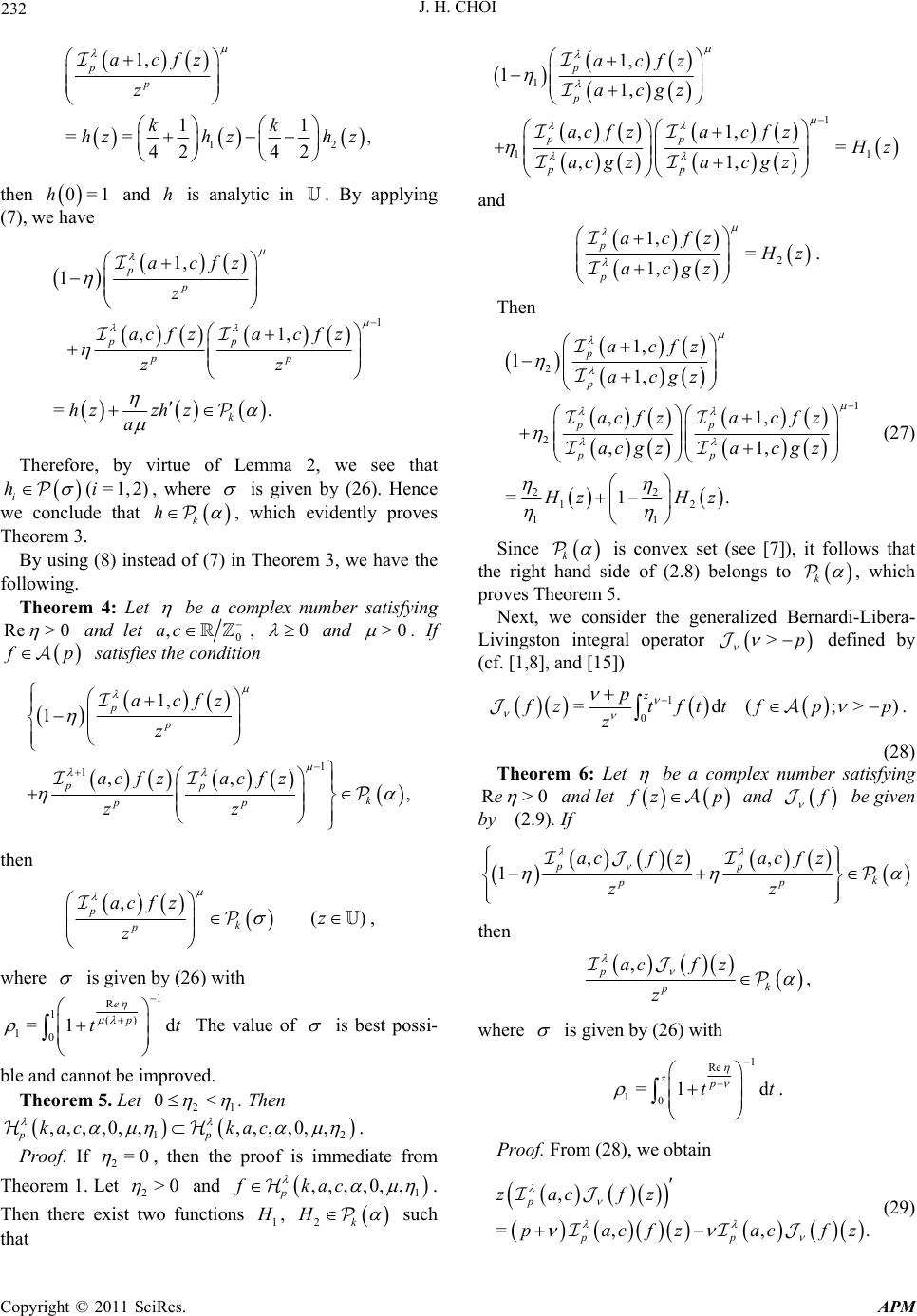 232 J. H. CHOI 12 1, 11 == 42 42 p p acfz z kk hzh zhz , then and is analytic in . By applying (7), we have 0=1hh 1 1, 1 ,1, =. p p pp pp k acfz z ac fzac fz zz hzzhz a Therefore, by virtue of Lemma 2, we see that , where (= 1, 2) i hi is given by (26). Hence we conclude that k h , which evidently proves Theorem 3. By using (8) instead of (7) in Theorem 3, we have the following. Theorem 4: Let be a complex number satisfying Re> 0 and let 0 ,ac , 0 and >0 . If f p satisfies the condition 1 1 1, 1 ,, , p p pp k pp acfz z ac fzacfz zz then ,() p k p ac fzz z , where is given by (26) with 1 R 1() 10 =1 d e p t t The value of is best possi- ble and cannot be improved. Theorem 5. Let 2 0< 1 . Then 1 ,,,,0,, ,,,,0,, pp kac kac 2 . Proof. If 2=0 , then the proof is immediate from Theorem 1. Let 2>0 and 1 ,,, ,0, , p fkac 1 . Then there exist two functions H , 2k H such that 1 1 11 1, 11, ,1, = ,1, p p pp pp acfz acgz acfza cfz H z acgza cgz and 2 1, = 1, p p acfz H z acgz . Then 2 1 2 22 12 11 1, 11, ,1, ,1, =1. p p pp pp acfz acgz ac fzac fz ac g zac gz HzH z (27) Since k is convex set (see [7]), it follows that the right hand side of (2.8) belongs to k , which proves Theorem 5. Next, we consider the generalized Bernardi-Libera- Livingston integral operator defined by (cf. [1,8], and [15]) >p 1 0 =d(; z p>) f ztfttfp z p. (28) Theorem 6: Let be a complex number satisfying R>0e and let f zp and f be given by (2.9). If ,, 1pp k pp acfzacfz zz then , p k p acfz z , where is given by (26) with 1 Re 10 =1 d zp tt . Proof. From (28), we obtain , =, , p pp zac fz pacfzacf .z (29) Copyright © 2011 SciRes. APM  J. H. CHOI 233 Let ,= p p acfzhz z . Then, by virtue of (29), we have ,, (1 ) =. pp pp k acfzac fz zz zh z hz p Hence, by using Lemma 2, we obtain the desired result. Finally, we consider the converse case of Theorem 1 as follows. Theorem 7: Let ,,,,,,0 p fkac ,, . Then p ,,,,fkac for <zR, where is given by R 22 = 12 a R aaa 1 . (30) Proof. Let 1, =1, p p acfz Hz acgz and 0 , =1, p p ac g z Hz acgz and since , it follows that ,,,,0, ,0 p fkac k H and 0k H hz . Proceeding as in Theorem 1, for =1Hz and =1 hz 0 Hz with , , we obtain k0 hh 1 2 0 1 1 0 2 2 0 1, 11 11, ,1, ,1, =1 1 =42 1 1 421 p p pp d pp acfz acgz acfza cfzV ac g zac gz zh z hz ah zh z khz ah zh z khz ah By applying Lemma 3, for and (=0,1, 2) i hi =<1zr , we have 0 2 2 Re 1 21 Re 1112 1 2 Re11112 12 21 Re . 1112 i i i i i zh z hz ah rr hz ar r r hz ar r arar a hz ar r (31) Hence, the hand right side of (31) is positive for =<zrR , where is given by (30). This completes the proof of Theorem 7. R Theorem 8. Let . Then ,,,,,,0 p fkac ,,,,,,fkac p for <zR , where is given by R 1 22 =1 21 Rp p pp . (32) Proof. Let , =, p p ac fz Hz acgz and 0 , =1, p p ac g z Hz acgz and since ,,,,0, ,0 p fkac , it follows that k H and 0 H . Then, by using same methods as in the proof of Theorem 7, we obtain the required result. 3.Acknowledgements This work was supported by Daegu National University of Education Research Grant in 2010. 4. References [1] S. D. Bernardi, “Convex and Starlike Univalent Func- tions,” Transactions of the American Mathematical Soci- ety, Vol. 135, 1969, pp. 429-446. doi:10.1090/S0002-9947-1969-0232920-2 Copyright © 2011 SciRes. APM  J. H. CHOI Copyright © 2011 SciRes. APM 234 [2] B. C. Carlson and D. B. Shaffer, “Starlike and Prestarlike Hypergeometric Functions,” SIAM Journal on Mathe- matical Analysis, Vol. 15, No. 4, 1984, pp. 737-745. doi:10.1137/0515057 [3] N. K. Cho, O. S. Kwon and H. M. Srivastava, “Inclusion Relationships and Argument Properties for Certain Sub- classes of Multivalent Functions Associated with a Fam- ily of Linear Operator,” Journal of Mathematical Analy- sis and Applications, Vol. 292, No. 2, 2004, pp. 470-483. doi:10.1016/j.jmaa.2003.12.026 [4] A. W. Goodman, “Univalent Functions, Vol. I, II,” Po- lygonal Publishing House, Washington, 1983. [5] J.-L. Liu and K. I. Noor, “Some Properties of Noor Inte- gral Operator,” Journal of Natural Geometry, Vol. 21, 2002, pp. 81-90. [6] S. S. Miller, “Differential Inequalities and Caratheodory Functions,” Bulletin of the American Mathematical Soci- ety, Vol. 81, 1975, pp. 78-81. doi:10.1090/S0002-9904-1975-13643-3 [7] K. I. Noor, “On Subclasses of Close-to-Convex Functions of Higher Order,” International Journal of Mathematics and Mathematical Sciences, Vol. 15, No. 2, 1992, pp. 279-289. doi:10.1155/S016117129200036X [8] K. I. Noor, “On New Classes of Integral Operators,” Journal of Natural Geometry, Vol. 16, 1999, pp. 71-80. [9] K. I. Noor and M. Arif, “Generalized Integral Operators Related with p-Valent Analytic Functions,” Mathematical Inequalities Applications, Vol. 12, No. 1, 2009, pp. 91-98. [10] J. Patal and N. E. Cho, “Some Classes of Analytic Func- tions Involving Noor Integral Operator,” Journal of Mathematical Analysis and Applications, Vol. 312, No. 2, 2005, pp. 564-575. doi:10.1016/j.jmaa.2005.03.047 [11] B. Pinchuk, “Functions with Bounded Boundary Rota- tion,” Israel Journal of Mathematics, Vol. 10, No. 1, 1971, pp. 7-16. doi:10.1007/BF02771515 [12] S. Ponnusamy, “Differential Subordination and Bazilevic Functions,” Proceedings Mathematical Sciences, Vol. 105, No. 2, 1995, pp. 169-186. doi:10.1007/BF02880363 [13] H. Saitoh, “A Linear Operator and Its Applications of First Order Differential Subordinations,” Mathematica Japonica, Vol. 44, 1996, pp. 31-38. [14] J. Sokół and L. Trojnar-Spelina, “Convolution Properties for Certain Classes of Multivalent Functions,” Journal of Mathematical Analysis and Applications, Vol. 337, No. 2, 2008, pp. 1190-1197. doi:10.1016/j.jmaa.2007.04.055 [15] H. M. Srivastava and S. Owa (Eds.), “Current Topics in analytic Function Theory,” World Scientific, Singapore, 1992. |

